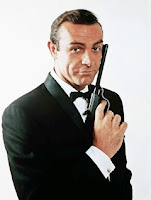Thank The Incredible Suit's brilliant idea for this; to chronologically blog about each of the 22 official James Bond films on a monthly basis that will take us neatly to the release date for the next installment. Fantastic, yes? Now, I can only guess that by Thunderball I will have reverted to my usual sweary smartarse self but for now, here's my relatively simple assessment of the first film in the canon, Dr No. Enjoy.
Dr No. 1962. d. Terence Young.
To chronologically review the entire Bond back catalogue I initially considered emptying my memory cache of said films, Spotless Mind-style, thus able to greet each film with fresh, unfettered expectations. I reversed this decision almost immediately for the same two reasons you can’t fix wheels to clouds; it’s impossible and pointless. I can’t deny the rich history of Bond films even if I try hard enough to shit myself. The iconography of said franchise is so ingrained in our culture that just by wearing a dinner jacket a man believes himself to be the spitting image of 007, and surreptitiously locks his fingers into a pistol shape at any given opportunity (honestly, a rotting gibbon’s corpse could be thrust into a tux and bowtie to achieve a favourable comparison with the suave super spy).
Think he's James Bond. Is James Bond.
So it was with cosy familiarity that my eyes settled on Bond’s first big screen outing Dr. No. Familiarity was a word then unknown to the franchise as began Terence Young’s often violent and always glamorous foray into filming the British agent’s adventures. Bob Simmons’ brief turn as 007 in the opening gun barrel sequence neatly encapsulate the film as a whole; in the black and white we have the mundane monochrome (the loose version of reality against which the narrative is set with its lung-troubling civil servants and gloomy London) instantly transposed by Bond’s appearance. Therein the blood runs red and the psychedelic insanity of the credits sequence tips its porkpie hat to the fantastical exploits to come. All to the tune of Monty Norman’s triumphantly brassy James Bond theme (although his oft whimsical calypso-lead score might be best described as a better geographical, than a cinematic fit).
Of course, the film’s biggest weapon was probably also its cheapest: Sean Connery. In just five words (and one of those is repeated) the “Glaswegian Lorry Driver” (©Ian Fleming) delivers James Bond with dazzlingly underplayed panache. Exuding a magnetic confidence, Connery inhabits the part with an air of detached humanity that befits someone used to killing for Queen & Country. Witness the way he dispassionately fires a volley of bullets into would-be assassin Professor Dent; he gets the job done and makes no bones about it. How very British! Not the everyman of Hitchcock thrillers, this is the lady-laying lawman with whom the men don’t empathise, but aspire to be.
The plot, such as it is, starts out as the relatively traditional fare of slain agents and international top secrets but soon eschews these elements for pulpy 1950’s comic book nonsense. Just as Doctor Who’s TARDIS is a vehicle to excitement, here the spy genre serves as a convenient pretext to far greater hi-jinx involving an absurd but visually impressive sci-fi base courtesy of Ken Adam. And rather cheekily, although world political dichotomies are acknowledged and he’s acting on behalf of the western free world, Bond is crucially positioned as a world-saver, not a Commie crusher. Labelled as “The 1st James Bond Film” producers Saltzman & Broccoli were clearly mapping out a plan that involved sequels and the worldwide market. You don’t get much more lucrative than the entire world’s population…
 |
| Dr. Not nostril-deep in aviary muck |
Ludicrous though the story is, just be grateful that its literary ending, in which the titular villain drowns in a heap of bird crap, was abandoned in favour of a fiery round of fisticuffs (not an easy task when your opponent has steel claws). Of whom, Joseph Wiseman’s nefarious nemesis is lent a gravitas hitherto undeserved of the material given to him, effectively writing the blueprint for every megalomaniac that follows; two thirds menace to one wonky-eyed charm.
 |
| Some woman or other |
Relatively slow pacing aside, the film’s weakest link is one that shall continue throughout much of the franchise’s lifespan; its depiction of women. Honeychile Ryder’s seashore introduction might be an enduring image, but it’s an unbalanced trade-off for Rizla-thin characterisation. Arguably, all of the film’s subsidiary characters are little more than narrative ciphers, but the females really get the short straws in terms of disposability. Look at them, use them, overpower them and patronise them by all means, but give them satisfying roles to fulfil within the plot? Don’t be stupid mate, look at the pretty ladies and grab a hold of your PPK, phwooar! And the less said about the credulity of the Caribbean ’s superstitious natives the better…
But 1962’s sexual and racial politics into 2011’s perceived equality doesn’t go; I might as well criticise Henry VIII for not going to Relate. With Bondian tropes established so successfully in this initial entry it’s hard to fault this film's sheer brio. Whilst yet to achieve the giddy highs the series would come to expect, Dr No is still an assured and audacious movie that easily accomplishes its own remit to launch James Bond as it intended to carry on.
7/10




I like this a lot. To be fair you had me at "The Incredible Suit's brilliant idea".
ReplyDeleteThe pleasure, the privilege was mine.
ReplyDelete